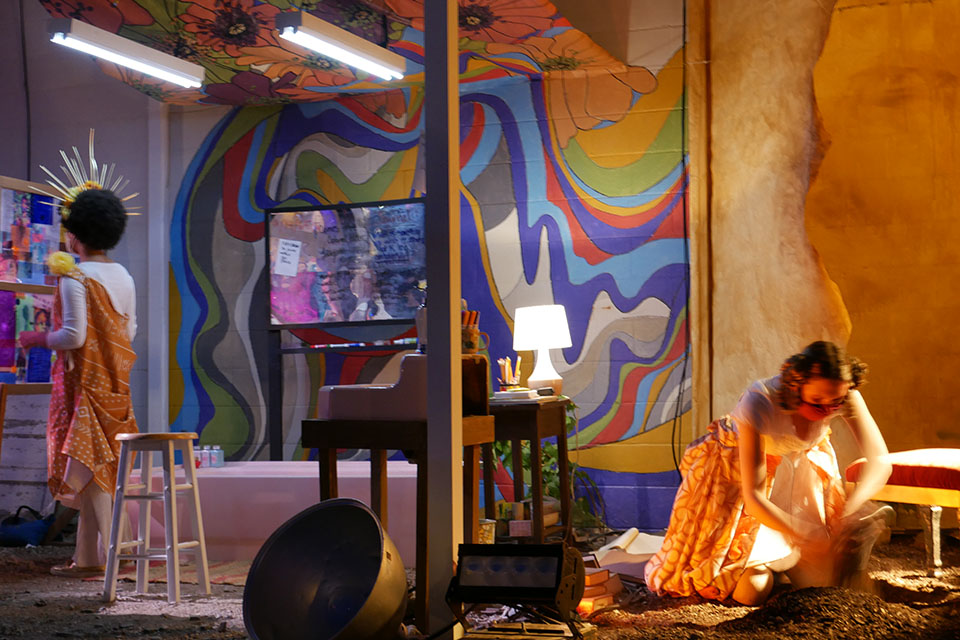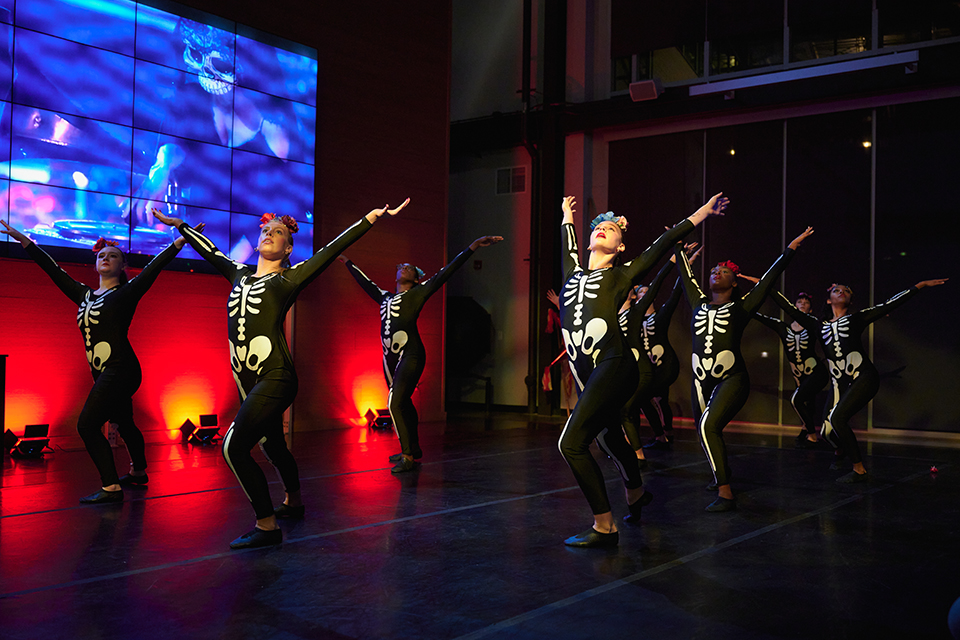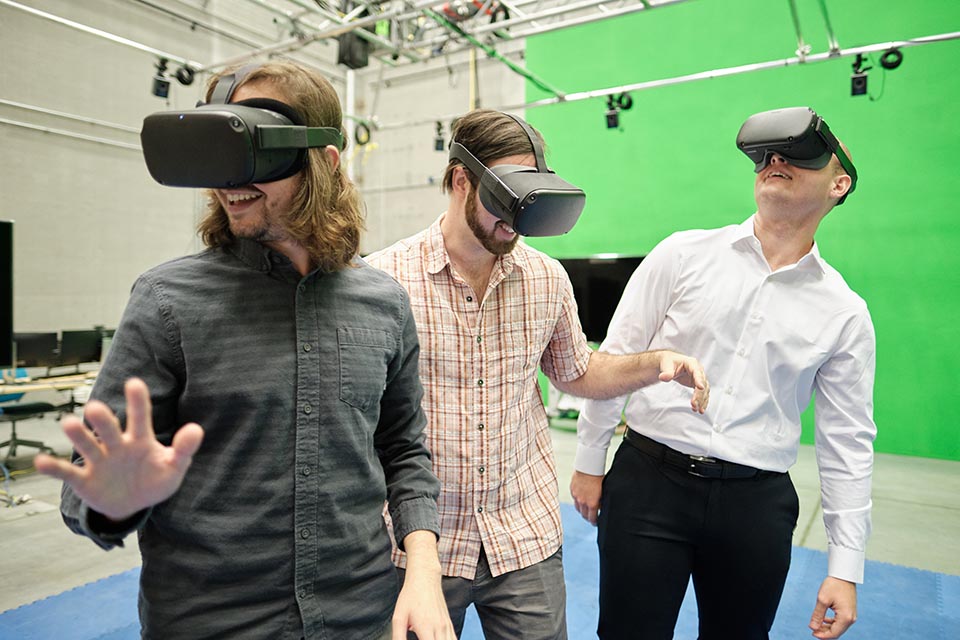The future of immersive entertainment: UNCSA charts the course
Step into a world where reality blends seamlessly with imagination, where every corner holds a story waiting to be explored. This isn’t just entertainment; it's an invitation to immerse yourself in worlds crafted with passion and purpose. Immersive entertainment, the captivating fusion of technology, creativity and collaboration, has emerged as a beacon of innovation in the 21st century, and UNCSA grads will be among the trailblazers.
Immersive entertainment allows the audience, viewer or participant to be surrounded by or interact with the narrative environment. As the curtain rises on this new frontier, deans and faculty explain how UNCSA stands at the forefront, preparing a generation of innovators poised to redefine how we experience art and narrative.
Immersive revolution: The craving for engaging experiences
Public interest in immersive entertainment accelerated after the COVID-19 pandemic as art enthusiasts worldwide emerged from their homes, seeking to reconnect in multi-dimensional experiences.
“People are hungry for an experience they can walk into,” says Dean of Filmmaking Deborah LaVine. “They want to be involved, not just entertained.”
Michael Kelley, Dean of Design and Production (D&P), agrees. “People don’t only want to sit in a theater and watch ‘Hello Dolly!’ anymore. They want something more dynamic and engaging,” he says.
Immersive entertainment’s path to prominence is marked by iconic theatrical experiences like the long-running “Death No More” in New York City, blockbuster films including “Jurassic Park” and “Avatar,” and popular theme park attractions like Disney’s Toy Story Land and Universal’s Wizarding World of Harry Potter.

The Schools of Drama and Design & Production put on the outdoor immersive entertainment performance "Love and Depositions" in the spring of 2021 as a way for audiences to experience theater while social distancing. / Photo: Marina Zurita
Andy Paris, who teaches devised theater in the School of Drama, says the development of immersive entertainment has taken two tracks. “There is the technological trajectory, with tools like virtual reality (VR) and augmented reality (AR), and there is physical immersion, where you place yourself in the surroundings,” he explains.
Though its future is yet to be written, immersive entertainment is expected to grow exponentially worldwide and is projected to generate $426 billion by 2030. Projections include growth in theme park attendance, films and gaming, interactive theatrical experiences, and art installations.
Creating the future of immersive entertainment
Whichever direction immersive entertainment takes, UNCSA grads will be well equipped to lead the way.
D&P recently launched a graduate animatronics program that Kelley says is grounded in the arts but also utilizes science and technology, filling a specific need in the entertainment industry. Beyond animatronics, the specific needs of immersive entertainment are incorporated into the curriculum of disciplines like sound and lighting, wigs and makeup, costumes, props and scenic design.
“It is all about transferable skills,” Kelley says. “If you can design for stage productions, you have the skills to design for other settings.”
Paris says the School of Drama trains actors to be present in the event, whatever the form and structure. “What is required of the actor is intense listening, being able to be present, to breathe, to follow an impulse,” he says. “That fundamentally does not change with location.”
Training in devised theater and other less traditional structures will develop versatile actors and directors, Paris adds. “The School of Drama is leaning forward, spending time and energy in the present day to prepare our students for success no matter what comes next.”
The School of Dance is also well positioned to embrace this wave of immersive entertainment, collaborating across disciplines to tap into immersive experiences, Dean Endalyn Outlaw says.

Holiday Suite was a 2023 collaboration between the Schools of Dance, Film, Music and Drama that immersed audiences in various cultural traditions. / Photo: Wayne Reich
“Projects like Holiday Suite — a collaboration between dance, film, music and drama — immerse audiences in cultural traditions, showcasing the potential of interdisciplinary collaboration. Through workshops like CineDance (choreography and performance that is especially devised for motion-picture photography) students will hone their skills in each other's disciplines, navigating this unique intersection between dance, film and emerging technology,” she says.
“Moving forward, we will focus on integrating immersive techniques into our curriculum to enhance students' interdisciplinary skills,” Outlaw adds.
Harmonizing art and technology
The convergence of music and cutting-edge technology is not just a trend but a foundational element of the curriculum. As industries evolve, the School of Music adapts, ensuring students are ready for the demands of modern entertainment landscapes. Dean Saxton Rose says that training organically supports immersive entertainment. For example, some music is composed to be played into a headset for gaming.
“The School of Music is actively connecting music and technology in a number of ways,” Rose says, pointing to the Composition for Film and Visual Media graduate program, the new UNCSA Media recording label, and the state-of-the-art recording studio and sound stage.
This focus on technological integration in music can also be seen in the School of Filmmaking's efforts to harness similar advancements, adapting to the growing demand for immersive and interactive media. The School of Filmmaking "recognizes the voracious appetite that young artists have for creating AR, VR and other immersive products, and the public’s desire to consume the experiences," LaVine explains.
“We have a program for that. We are on top of that technology, but the most important thing we teach is the human connection,” she says. “Storytelling is the core of our curriculum. We merge classic cinema tools with visual effects, puppetry, animatronics, and new tools like AR and VR. Students choose the vehicle, but the story is paramount.”

Virtual reality and augmented reality are part of the technical trajectory incorporated in immersive entertainment. / Photo: Wayne Reich
Whatever the vehicle, conservatory leaders agree that the ultimate goal is arriving at a compelling story. “Amidst the technological whirlwinds, let us not forget the journey's foundation: the spark of imagination, the collaborative spirit, and the unwavering belief in the power of stories to shape us, to move us, to make us dream,” says Filmmaking faculty Bob Keen.
“In the years to come, the tools may change, the landscapes may morph, but one thing will remain constant: the human desire to paint our dreams onto light, to share them with the world, and to embark on this extraordinary journey together.”
Get the best news, performance and alumni stories from UNCSA.
SUBSCRIBE TO OUR NEWSLETTERS(OPENS IN NEW TAB)
April 23, 2024






